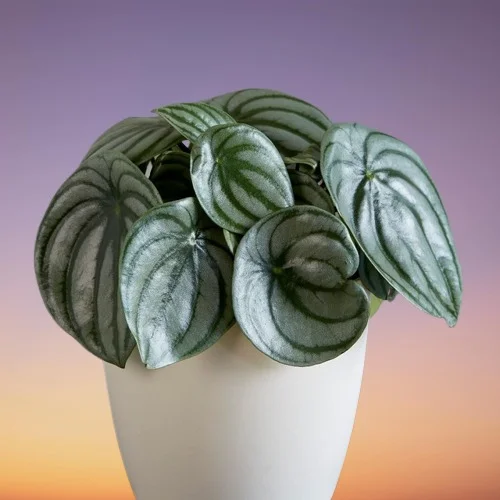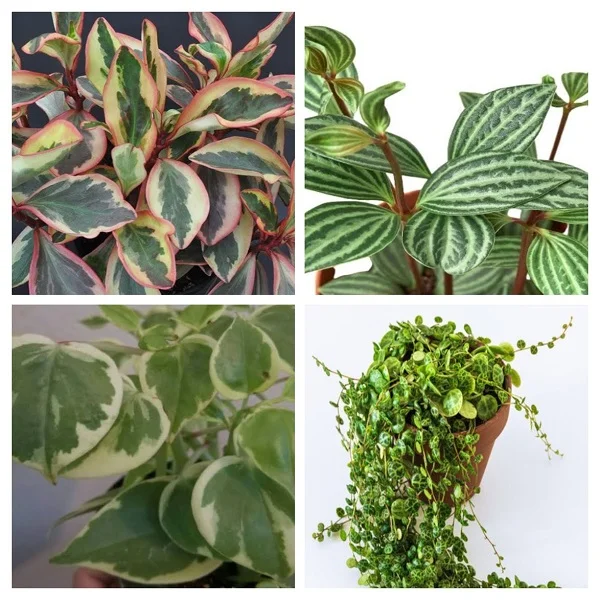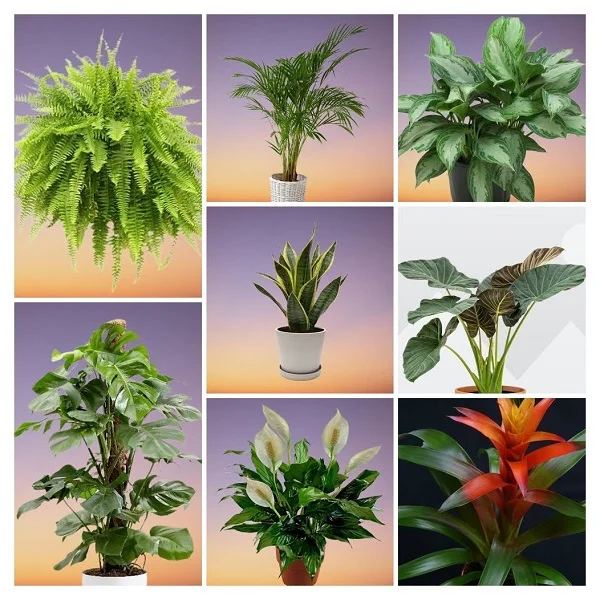Watermelon Peperomia (Peperomia argyreia) Indoor Care, Propagation and Growing Problems
Some links in this post may be affiliate links
Watermelon Peperomia (Peperomia argyreia) blossoms in bright indirect light, average warmth, moderate humidity and moderately moist, rich, well-drained soil coupled with monthly feeding in the growing period.
Watermelon Peperomia also called Watermelon Begonia is among the popular Peperomia varieties on account of its compact size and magnificent foliage.
Watermelon Begonia is a compact, upright, bushy plant with slightly-fleshy, oval-shaped, green leaves which are strikingly marked with curved silver stripes resembling the skin of a watermelon, hence the common name.
The stems are red-colored and the flowers are insignificant, rat-tail, flower-heads made up of green flowers on an upright spike.
The spectacular foliage make Watermelon Peperomia one of the best plants for the home as it will be a magnificent sight in any space.

Botanical name: Peperomia argyreia
Synonmy name: Peperomia sandersii
Family: Piperaceae
Common names: Watermelon Peperomia, Watermelon Begonia
Origin
Peperomia argyreia is native to the tropical rain forests of northern South America where it grows as an epiphyte on trees.
Size
Watermelon Begonia grows to a height of about 12 inches which makes it one of the best plants for a study table or an office desk without sunlight.
Is Watermelon Peperomia toxic?
Peperomia argyreia like other Peperomia Plants is non-toxic to both humans and pets. It is among the pet-safe plants ideal for growing in a home with kids and pets.
Where to Buy
Watermelon Peperomia is a valuable addition to any plant collection. You may obtain these plants online from Amazon (Link to Amazon).
Peperomia argyreia Care Indoors
Watermelon Peperomia (Peperomia argyreia) blossoms in bright indirect light (dappled light), average warmth of 18-250C, humidity of 50-60% and moderately moist, fertile, well-drained, succulents potting mix coupled with monthly feeding during the growing period.
Peperomia argyreia requires regular pruning to keep the plant neat and tidy, to encourage a bushy growth as well as minimize pest and disease infestations. Repotting is only needed when the plant becomes extremely pot-bound as it grows best when the roots are confined. Keep reading for more on these growing conditions and how to achieve them.

Watering
Water Watermelon Peperomia liberally during the growing season and allow the top 2-3 inches of soil to dry out between waterings to keep the soil moderately moist.
Significantly decrease watering during the cold season to keep the soil barely moist as growth is minimal at this time.
Ensure that the pot has a drainage hole to prevent the soil from getting soggy as it can lead in root-rot and eventual death of the plant. Learn more on how to water indoor plants the right way.
Light Requirements
Watermelon Peperomia grows best in bright indirect light. Keep it away from direct sunshine as it may lead to scorching of the leaves.
Too little light will result in a leggy plant as the plant tries to reach for the light source. Therefore, where the natural lighting is not adequate, consider using a grow light to supplement it. Check out these full spectrum grow lights on Amazon.
Once in a while turn the pot to ensure that the plant receives light on all sides for uniform growth and also prevent legginess.
Temperature and Humidity
Average warmth of 18-250C is ideal for Watermelon Peperomia. A room temperature that is comfortable for you is ideal for this plant. Keep it away from drafts as they can result in sudden changes in temperatures which will lead to reduced growth, brown leaf tips and leaf drop.
Watermelon Begonia will grow in moderate humidity of 50-60%. Too low humidity can cause the plant to develop brown leaf tips and edges. To increase humidity, set pot on a wet pebble tray or use a cool mist humidifier. You may also grow the plant in a well-lit bathroom, kitchen or laundry area. Watermelon Peperomia is among the best plants for the bathroom.
Regularly clean the leaves by damp-wiping with a soft cloth to get rid of dust as well as discourage pest and disease infestation. Ensure that there is good air circulation to minimize fungal diseases.
Potting Soil
The best potting soil for Peperomia argyreia should be rich in organic matter, loose and free-draining to avoid getting soggy soil. The soil should be loose enough to allow water to drain out fast enough. Cactus and succulents mixes are ideal for this plant.
Fertilizer
Feed Watermelon Peperomia with a balanced, liquid fertilizer every 4 weeks during the growing period for lush growth. Withhold feeding in the cold season as growth is minimal and feeding at this time may lead to fertilizer burn and death of the plant.
Repotting
Repot Watermelon Peperomia during the growing season only when the plant has become extremely pot-bound as it grows best when the roots are confined.
Use a pot one size larger than the current one and ensure that the pot has a drainage hole to prevent the soil from getting soggy as it can lead to root-rot. Check out these pots with multi mesh drainage holes on Amazon.
Pruning
Pruning Watermelon Peperomia involves regular removal of dead foliage to maintain the plant neat as well as minimize pest and disease infestations.
Propagation
Watermelon Peperomia (Peperomia argyreia) propagation can be done at the beginning of the growing season from leaf cuttings or by plant division.
How to propagate Watermelon Peperomia from leaf cuttings in water
The leaf cuttings root easily, therefore there is no need for a rooting hormone. Take leaf cuttings from a healthy Watermelon Peperomia and ensure each leaf cutting has a petiole.
Allow sometime for the formation of a protective callus tissue over the cuts of the leaf cuttings to prevent rotting.
Place the leaf cuttings in a jar of clean plain water and change the water every 5-7 days.
Position the set up in a warm, well-lit place until growth begins at the base of the cuttings leaf petiole. Allow enough time for substantial growth of the roots and new leaves before tranplanting.
Transfer the rooted cuttings to individual pots and place in a cool shaded place. For a fuller plant, transfer several cuttings into one pot.
Maintain the soil moist until the new Watermelon Peperomia are well established after which you can begin routine care.
How to propagate Watermelon Peperomia by plant division
Water the Watermelon Peperomia thoroughly at least one day before to make it easier to divide and also hasten establishment. A well hydrated plant suffers less shock and takes a shorter time to take root.
Take the plant out of its pot and divide it into several sections. Ensure that each section has adequate roots for faster establishment.
Pot these sections in individual pots and place in a warm, well-lit place and maintain the soil moist until new growth emerges on the sections.
Allow the new Watermelon Peperomia to be well established before transplanting after which you can begin routine care.
Related: How to Propagate Radiator Plants (4 Easy Methods of Peperomia Propagation)

Peperomia argyreia Problems
Watermelon Peperomia (Peperomia argyreia) problems include drooping leaves, dropping leaves, brown, crispy leaves, brown leaf tips and edges, root-rot, pests among others. Continue reading for more on these problems, their remedies and solutions.
Drooping leaves
Watermelon Peperomia drooping leaves are caused by many and varied reasons. One possible reason is exposure to direct sunlight. Thoroughly water the plant immediately and it should recover. Move it to a more shaded spot or instal a light curtain to filter direct sunlight from reaching the leaves.
The second possible reason for drooping leaves in Watermelon Peperomia is overwatering which results in soggy soil. To avoid getting soggy soil, ensure that the pot has a drainage hole and that the soil is loose and free-draining. In addition, reduce watering in the cold season to maintain the soil barely moist as growth is minimal at this time.
The third possible reason for drooping leaves in Watermelon Peperomia is underwatering which implies that there is too little moisture in the soil. As such, there is no water in the soil for the plant to take up to the leaves and other parts.
Thoroughly water the plant immediately and it should perk up. Thereafter, water it liberally during the growing season and allow the soil to dry out between waterings.
Related: 14 reasons why Peperomia leaves are drooping and how to fix them
Dropping leaves
Watermelon Peperomia dropping leaves are caused by various reasons. One possible cause is that the temperature is too low. Move it to a warmer spot away from cold drafts and maintain an average room temperature of 18-250C.
The second possible cause of Watermelon Peperomia dropping leaves is that the plant has been underwatered causing the foliage to wilt and drop. Water the plant liberally during the growing season and allow the soil to dry out between waterings but reduce watering during the cold season.
Related: 12 reasons why Peperomia is dropping its leaves with remedies
Wilted, discolored leaves, corky swellings under the leaves
Watermelon Peperomia wilted, discolored leaves with corky swellings under the leaves are an indication of root-rot which is brought about by soggy soil as a result of poor drainage of both the pot and the soil.
To prevent the soil from getting soggy, ensure that the soil is free-draining and that the pot has a drainage hole. Isolate the affected plant to prevent spread to other plants and treat it appropriately for the disease. Learn more on how to treat root-rot in houseplants.
Diseases
One more common disease in Watermelon Peperomia is leaf spot. Isolate the affected plant to discourage spread to the rest of the plants and treat it appropriately for the disease.
Pests
Common pests in Watermelon Peperomia are spider mites, whiteflies, scale insects and mealy bugs. Isolate the affected plant to prevent spread to other plants and treat it for the pests. Learn how to identify and control houseplants pests.
Leggy stems (growth)
Watermelon Peperomia leggy stems are due to low light. This is an attempt by the plant to reach the light source. Cutback the leggy stems to rejuvenate growth and move the plant to a brighter spot where it will receive bright indirect light or instal grow lights if you do not have adequate lighting in your home. Check out this guide on understanding light for houseplants.
Brown leaf tips and edges
Brown leaf tips and edges in Watermelon Peperomia are caused by two possible reasons. Remove the damaged leaves to keep the plant tidy. One possible reason for brown leaf tips and edges is sudden changes in temperature due to drafts.
Keep the plant away from drafts like drafty windos, windy doors, hot vents, air conditioners and others to maintain warm temperatures within the range of 18-250C. Check out this guide on understanding temperature for houseplants.
The second possible reason for Watermelon Peperomia brown leaf tips and edges is too low humidity. To raise humidity, set pot on a wet pebble tray. You may also grow the plant in a well-lit bathroom, kitchen, laundry area and other moist areas in the home. Learn more on how to raise humidity for houseplants.
Brown, crispy leaves
Brown, crispy leaves in Watermelon Peperomia are caused by too dry air (low humidity) as it prefers a humid environment. Set the pot on a wet pebble tray or use a cool mist humidifier to raise humidity. The plant can also be grown in a closed terrarium as high humidity can be maintained inside a terrarium.
Dull and lifeless leaves
Watermelon Peperomia dull and lifeless leaves are due to exposure of the plant to hot direct sunlight. Protect the plant from hot direct sunlight by installing a light curtain to filter sunlight or move it to a shadier spot.
You liked it? Share on social media.
Related Content
Amazon Associates Disclosure
Homeplantsguide.com is a participant in the Amazon Services LLC Associates Program, an affiliate advertising program designed to provide a means for sites to earn advertising fees by advertising and linking to amazon.com.





